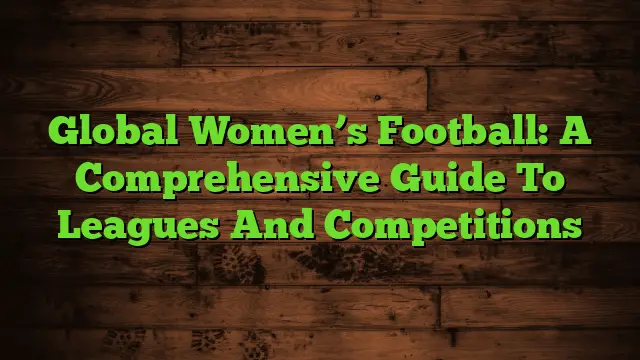The world of sports is constantly evolving, and women’s football is experiencing a remarkable surge in popularity and professionalism. This comprehensive guide delves into the fascinating landscape of women’s football leagues, exploring their history, structure, challenges, and the bright future ahead. We’ll examine various leagues worldwide, compare their strengths and weaknesses, and discuss the factors contributing to their growth. You’ll learn about the different playing styles, the impact of media coverage, and the ongoing fight for equality in the sporting arena. Get ready to discover the dynamic world of women’s football!
The history of women’s football is often overlooked, but it’s a rich tapestry of determined women who defied societal norms to play the game they loved. Early organized leagues emerged in the late 19th and early 20th
centuries, facing significant opposition and prejudice. However, these pioneering women paved the way for future generations.
The Revival and Professionalization
After periods of decline and bans, women’s football experienced a significant revival in the latter half of the 20th century. The establishment of national leagues and international competitions marked a crucial turning point, laying the foundation for the professional leagues we see today.
Major Women’s Football Leagues Around the World
The English FA Women’s Super League (WSL)
The WSL is one of the most prominent leagues globally, boasting high-profile players and competitive matches. Its growth reflects the increasing investment in women’s football in England.
National Women’s Soccer League (NWSL) – USA
The NWSL is a professional women’s soccer league in the United States, featuring some of the world’s best players. Its popularity has grown substantially in recent years.
Division 1 Féminine – France
France’s top women’s football league, Division 1 Féminine, has seen a rise in popularity and competitiveness, attracting both domestic and international talent.
Bundesliga Frauen – Germany
The Bundesliga Frauen, Germany’s premier women’s football league, consistently ranks among the top leagues in Europe, known for its tactical approach and skilled players.
Other Notable Leagues
Beyond these major leagues, many other countries boast successful and developing women’s football leagues, including Spain’s Primera División Femenina, Italy’s Serie A Femminile, and Sweden’s Damallsvenskan. Each league offers unique characteristics and contributions to the global landscape.
The Structure and Format of Women’s Football Leagues
League Systems and Promotion/Relegation
Most women’s football leagues operate on a similar structure to their men’s counterparts, with a system of promotion and relegation between divisions. This dynamic keeps the competition exciting and ensures a pathway for aspiring clubs.
Season Length and Match Schedules
League seasons vary in length, typically ranging from spring to fall or autumn to spring. Match schedules are often organized to avoid conflicts with international competitions.
Playoff Systems and Championship Determination
The methods for determining league champions vary. Some leagues use a straightforward points-based system, while others incorporate playoff systems for added drama and excitement.
The Challenges and Opportunities Facing Women’s Football Leagues
Financial Sustainability and Investment
Securing adequate funding remains a significant challenge for many women’s football leagues. Increased investment from sponsors, broadcasters, and governing bodies is crucial for long-term sustainability.
Media Coverage and Visibility
Improved media coverage is essential for increasing the popularity and visibility of women’s football. More television broadcasts, online streaming, and media attention will help attract a wider audience.
Gender Equality and Equal Pay
The fight for equal pay and equal opportunities remains a core issue. Achieving genuine gender equality within the sport requires systemic changes and a commitment from all stakeholders.
Growing Fan Base and Community Engagement
Engaging with fans and building strong communities around women’s football teams is crucial for success. Initiatives like fan forums, social media engagement, and community outreach can strengthen the connection between fans and the sport.
Comparing Women’s Football Leagues: A Global Perspective
League Popularity and Viewership
The popularity of women’s football leagues varies by region and country. Some leagues have established large and passionate fan bases, while others are still striving for wider recognition.
Player Salaries and Transfer Fees
Player salaries and transfer fees in women’s football are still significantly lower than in men’s football. However, this disparity is gradually decreasing as investment increases.
Tactical Approaches and Playing Styles
Different leagues have distinct tactical approaches and playing styles. Some prioritize possession-based football, while others favor a more direct and counter-attacking approach.
Infrastructure and Facilities
Access to high-quality training facilities, stadiums, and support staff is essential for the development of players and the growth of the leagues.
The Future of Women’s Football Leagues
Expansion and Globalization
The future looks bright for women’s football. The expansion of leagues and the increasing global interest in the sport indicate a positive trajectory.
Increased Investment and Sponsorship
As women’s football gains popularity, the potential for increased investment and sponsorship opportunities is enormous. This will fuel further growth and development.
Technological Advancements and Fan Engagement
Technology is playing an increasingly important role in women’s football, enhancing the fan experience through live streaming, virtual reality, and other innovations.
The Role of Governing Bodies and Organizations
International football organizations play a critical role in supporting and promoting women’s football leagues globally. Their investments and initiatives are vital for the sport’s continued success.
Frequently Asked Questions
What are the main differences between women’s and men’s football leagues?
While the core rules are the same, key differences include funding, media coverage, player salaries, and overall global reach. Men’s leagues generally have significantly higher levels of funding and media attention.
How can I support women’s football?
Attend matches, follow teams and players on social media, watch games on TV or streaming platforms, and support brands that sponsor women’s football.
What are some challenges faced by women’s football leagues?
Major challenges include securing sufficient funding, gaining wider media coverage, combating gender inequality, and achieving equal pay with men’s leagues.
What are the biggest women’s football leagues in the world?
The NWSL (USA), WSL (England), Division 1 Féminine (France), and Bundesliga Frauen (Germany) are among the most prominent and successful leagues globally.
How can I get involved in women’s football?
You can get involved as a player, volunteer, coach, referee, or simply by being a dedicated fan and supporting the leagues and teams you love.
What is the future of women’s football leagues?
The future looks bright, with increasing investment, growing fan bases, and expanding global reach. Technological advancements will also play a big role in enhancing fan engagement and the overall game.
Final Thoughts
The world of women’s football is vibrant, dynamic, and full of potential. The leagues discussed in this article represent just a fraction of the global landscape, yet they highlight the incredible progress made and the exciting future that lies ahead. From the pioneering days to the professional leagues we see today, women’s football has shown incredible resilience and determination. By understanding the history, structure, challenges, and opportunities within these leagues, we can all contribute to the continued growth and success of this inspiring sport. Support your local teams, watch the games, and be part of this incredible journey! Let’s celebrate the passion, skill, and dedication of the women who make women’s football the captivating spectacle it is.





